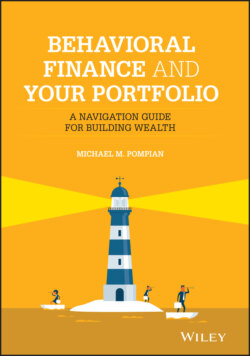Читать книгу Behavioral Finance and Your Portfolio - Michael M. Pompian - Страница 38
Emotional Biases
ОглавлениеAlthough emotion has no single universally accepted definition, it is generally agreed upon that an emotion is a mental state that arises spontaneously rather than through conscious effort. Emotions are related to feelings, perceptions, or beliefs about elements, objects, or relations between them; these can be a function of reality or the imagination. Emotions may result in physical manifestations, often involuntary. Emotions can cause investors to make suboptimal decisions. Emotions may be unwanted by the individuals feeling them, and while they may wish to control the emotion and their response to it, they often cannot.
Emotional biases are harder to correct for than cognitive errors because they originate from impulse or intuition rather than conscious calculations. In other words, a bias that is an inclination of temperament or outlook, especially a personal and sometimes unreasonable judgment, is harder to correct. When investors adapt to a bias, they accept it and make decisions that recognize and adjust for it rather than making an attempt to reduce it. To moderate the impact of a bias is to recognize it and to attempt to reduce or even eliminate it within the individual rather than to accept the bias. In the case of emotional biases, it may be possible to only recognize the bias and adapt to it rather than correct for it.
Emotional biases stem from impulse, intuition, and feelings and may result in personal and unreasoned decisions. When possible, focusing on cognitive aspects of the biases may be more effective than trying to alter an emotional response. Also, educating the investors about the investment decision-making process and portfolio theory can be helpful in moving the decision making from an emotional basis to a cognitive basis. When biases are emotional in nature, drawing them to the attention of the individual making the decision is unlikely to lead to positive outcomes. The individual is likely to become defensive rather than receptive to considering alternatives. Thinking of the appropriate questions to ask and to focus on as well as potentially altering the decision-making process are likely to be the most effective options.
Emotional biases can cause investors to make suboptimal decisions. The emotional biases are rarely identified and recorded in the decision-making process because they have to do with how people feel rather than what and how they think. The six emotional biases discussed are: loss aversion, overconfidence, self-control, status quo, endowment, and regret aversion. In the discussion of each of these biases, some related biases may be discussed.
Figure 2.2 Categorization of Twenty Behavioral Biases
Figure 2.2 below is a roadmap for the 20 biases that you will be seeing in the upcoming chapters.
